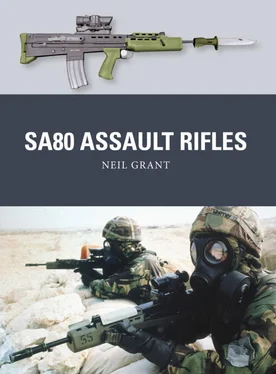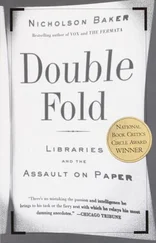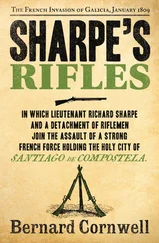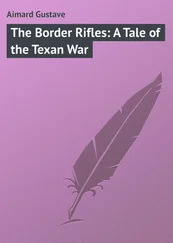Several wood-and-metal mock-up weapons were produced, to give an impression of what the eventual weapon designs might look like, but no actual prototypes were built during this phase. Existing weapons – including Stoner 63 and Armalite AR-18 assault rifles – were modified for firing tests of the new cartridges and to demonstrate various design concepts.
The preliminary study had also been asked to look at the future for the squad LMG. The terms of reference potentially allowed the selection of a larger calibre such as 7.62mm NATO for this, but instead the study advocated using a version of the IW, fitted with a bipod and a longer, heavier barrel to act as a ‘light support weapon’. On one level, this made good sense. A new LMG would be necessary anyway, and having all the weapons in the infantry section firing the same cartridge simplified logistics and allowed ammunition to be redistributed within the section if necessary.
The two weapons were intended to have an 80 per cent commonality of parts, bringing down the cost of manufacture for both weapons because only one set of drawings, masters, etc. would be needed, and reducing the number of spare parts required. Training would also be simplified, with infantrymen only needing to learn how to use, strip and maintain a single design, rather than a separate rifle and machine gun. It was not a revolutionary idea: the Warsaw Pact had adopted the RPK – effectively a version of their AK-47 assault rifle with a longer, heavier barrel and a bipod – as their standard LMG some years before. There were tensions between designing a good rifle and designing a good machine gun, however. Equally, the designers had to balance maximum commonality of design with optimizing the two weapons for their particular roles.
First, rifles are generally designed with accuracy in mind, and fire from a closed bolt. This means that cocking the action brings the bolt back to strip a cartridge off the magazine, then lets it go forward again to chamber the round. This round remains in the chamber until the trigger is pulled, when the cartridge detonates and the bolt moves backwards to eject the spent cartridge, strip the next round from the magazine and chamber it ready to repeat the sequence.
Pure automatic weapons (SMGs and machine guns) usually fire from an open bolt, however. Here, cocking the action brings the bolt back and holds it there. The chamber remains empty until the trigger is pulled, at which point the bolt runs forward, picks up a round from the magazine, chambers and immediately fires it. The detonation of the cartridge sends the bolt back, where it is caught and held, ready to go forward the next time the trigger is pulled, repeating the sequence. Open-bolt designs are less accurate, since the mass of the bolt slamming forward when the trigger is pulled moves the point of aim slightly, but they leave the barrel and chamber empty and open to the air for cooling between bursts. This latter feature is not important for a rifle, with its low rate of fire, but it becomes very important with machine guns because the chamber quickly heats up during automatic fire – sometimes to the point where chambered cartridges can ‘cook off’ and fire spontaneously.
Secondly, most NATO machine guns (including the British Bren and GPMG) have been equipped with quick-change barrels. The advantages are obvious: as the barrel starts to overheat from sustained automatic fire, the gunner can simply swap it out and continue firing using the spare barrel. Meanwhile, the original barrel is put aside to cool, allowing the machine gun to maintain a high rate of fire for a prolonged period. Fitting the LSW with a quick-change barrel required changes to the receiver, however, thus reducing commonality with the rifle. On the other hand, if it was fitted with a fixed barrel, its sustained-fire capability would inevitably be reduced.
Thirdly, the LSW would use the same 20- or 30-round box magazine as the rifle. This was not automatically a bad decision – the magazine-fed World War II-era Bren gun had been successful enough – and indeed box magazines had several advantages over belt feed. They were less likely to pick up contamination in muddy or snowy environments (which is why the Royal Marines often preferred the older Bren to the newer GPMG for Arctic deployments) and they were much easier to use on the move. It also meant that the riflemen and LSW gunners in the section could swap ammunition among themselves, even in action, without having to reload rounds from belts to magazines or vice versa. Using box magazines inevitably reduced the practical volume of sustained fire that could be achieved, however, and belt-fed machine guns had been preferred since World War II for exactly that reason. The obvious solution was to use a large-capacity drum that fitted into the same magazine well as the standard box; the Soviet RPK used a 75-round drum, for instance. While that worked for conventionally laid out weapons, however, the magazine well of a bullpup weapon was in the butt, making the use of a drum magazine awkward.
Although the designers were aware that all of these choices would reduce the weight of fire the proposed LSW could put down, their solution was simple. Whereas the weight of a conventional machine gun and its ammunition meant that each section could only carry one such weapon, the same section would be able to carry two of the new weapons and their lighter ammunition. Although each LSW would produce less firepower than a conventional machine gun, having two of them meant that the firepower of the section as a whole would actually be increased.
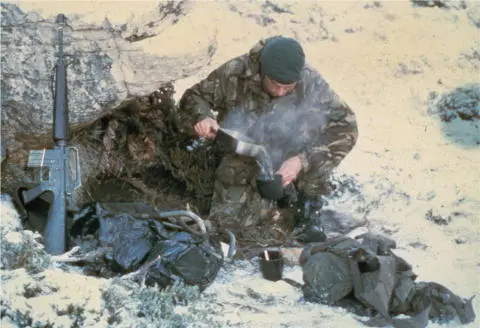
The SA80 was not the first 5.56mm rifle in British service; the armed forces bought a considerable number of M16s in the 1960s and 1970s, which were used by elite forces and units deployed for jungle warfare, such as this Royal Marine of the Mountain and Arctic Warfare Cadre in the mountains above Port Stanley during the 1982 Falklands War. (© IWM FKD 2032)
INITIAL FEASIBILITY STUDIES (1972–74)
Based on the results of the preliminary studies, the MoD began to develop a General Staff Target (GST 3518) – effectively, a formal statement of what was required from a weapon system. Meanwhile, RSAF Enfield produced 12 test weapons, known as the ‘Double O’ series since their serial numbers ran from 001 to 012, to test the preliminary study concepts. The weapons were all based on a common bullpup design, and were fitted with 4× Sight Unit, Small Arms, Trilux (SUSAT) optical sights. All weapons were set up for right-handed use, though they could be converted for left-handed use by unit armourers. The design featured a 20-round box magazine released by a catch on the right-hand side of the body, and a push-through safety catch. The selector switch included a three-round-burst setting as well as the usual semi- and full-automatic settings. Since the muzzle of any weapon fired from the shoulder on automatic tends to climb sharply, this setting prevented ammunition being wasted by cutting off the burst after three rounds, before recoil pulled the weapon too far away from the point of aim. (A similar device was later fitted to the US M16A2, in response to infantrymen in Vietnam expending all their ammunition in ‘spray and pray’ bursts, rather than aiming.)
The first six weapons (001–006) were 4.85mm IWs, firing from a closed bolt in both semi- and full-automatic modes. Weapon 007 was identical, but chambered for the 5.56mm NATO round used by the M16 and fitted with the ‘handbag’ sling used by the later ‘O’ series. Weapon 008 was fitted with an experimental 40mm grenade launcher under the barrel, to give a capability against area targets. Weapons 009–012 were 4.85mm LSWs, with a longer, heavier barrel and a rearward-folding bipod fitted just ahead of the handguard. The four LSWs fired from a closed bolt on semi-automatic, but from an open bolt on automatic or three-round-burst. This preserved the best features of both, but at the price of a complex mechanism and reduced commonality.
Читать дальше
